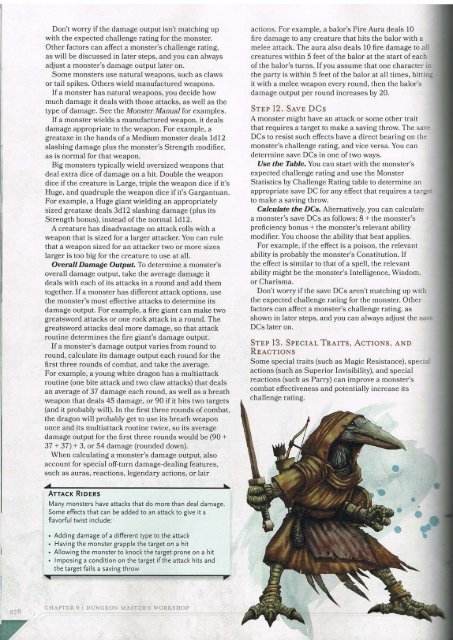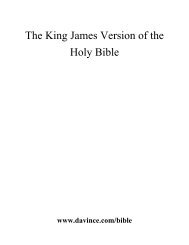Dungeon Master's Guide
Create successful ePaper yourself
Turn your PDF publications into a flip-book with our unique Google optimized e-Paper software.
,<br />
Don't worry if the damage output isn't matching up<br />
with the expected challenge rating for the monster.<br />
Other factors can affect a monster's challenge rating,<br />
as will be discussed in later steps, and you can always<br />
adjust a monster's damage output later on.<br />
Some monsters use natural weapons, such as claws<br />
or tail spikes. Others wield manufactured weapons.<br />
If a monster has natural weapons, you decide how<br />
much damage it deals with those attacks, as well as the<br />
type of damage. See the Monster Manual for examples.<br />
If a monster wields a manufactured weapon, it deals<br />
damage appropriate to the weapon. For example, a<br />
greataxe in the hands of a Medium monster deals ld12<br />
slashing damage plus the monster's Strength modifier,<br />
as is normal for that weapon.<br />
Big monsters typically wield oversized weapons that<br />
deal extra dice of damage on a hit. Double the weapon<br />
dice if the creature is Large, triple the weapon dice if it's<br />
Huge, and quadruple the weapon dice if it's Gargantuan.<br />
For example, a Huge giant wielding an appropriately<br />
sized greataxe deals 3dl2 slashing damage (plus its<br />
Strength bonus), instead of the normalldl2.<br />
A creature has disadvantage on attack rolls with a<br />
weapon that is sized for a larger attacker. You can rule<br />
that a weapon sized for an attacker two or more sizes<br />
larger is too big for the creature to use at all.<br />
Overall Damage Output. To determine a monster's<br />
overall damage output, take the average damage it<br />
deals with each of its attacks in a round and add them<br />
together. If a monster has different attack options, use<br />
the monster's most effective attacks to determine its<br />
damage output. For example, a fire giant can make two<br />
greatsword attacks or one rock attack in a round. The<br />
greatsword attacks deal more damage, so that attack<br />
routine determines the fire giant's damage output.<br />
If a monster's damage output varies from round to<br />
round, calculate its damage output each round for the<br />
first three rounds of combat, and take the average.<br />
For example, a young white dragon has a multiattack<br />
routine (one bite attack and two claw attacks) that deals<br />
an average of 37 damage each round, as well as a breath<br />
weapon that deals 45 damage, or 90 if it hits two targets<br />
(and it probably will). In the first three rounds of combat,<br />
the dragon will probably get to use its breath weapon<br />
once and its multiattack routine twice, so its average<br />
damage output for the first three rounds would be (90 +<br />
37 + 37) + 3, or 54 damage (rounded down).<br />
When calculating a monster's damage output, also<br />
account for special off-turn damage-dealing features,<br />
such as auras, reactions, legendary actions, or lair<br />
actions. For example, a balor's Fire Aura deals 10<br />
fire damage to any creature that hits the balor with a<br />
melee attack. The aura also deals 10 fire damage to all<br />
creatures within 5 feet of the balor at the start of each<br />
of the balor's turns. If you assume that one character ~<br />
the party is within 5 feet of the balor at all times, hittir::;<br />
it with a melee weapon every round, then the balor's<br />
damage output per round increases by 20.<br />
STEP 12. SAVE DCs<br />
A monster might have an attack or some other trait<br />
that requires a target to make a saving throw. The sa,·e<br />
DCs to resist such effects have a direct bearing on the<br />
monster's challenge rating, and vice versa. You can<br />
determine save DCs in one of two ways.<br />
Use the Table. You can start with the monster's<br />
expected challenge rating and use the Monster<br />
Statistics by Challenge Rating table to determine an<br />
appropriate save DC for any effect that requires a tar e·<br />
to make a saving throw.<br />
Calculate the DCs. Alternatively, you can calculate<br />
a monster's save DCs as follows: 8 + the monster's<br />
proficiency bonus + the monster's relevant ability<br />
modifier. You choose the ability that best applies.<br />
For example, if the effect is a poison, the relevant<br />
ability is probably the monster's Constitution. If<br />
the effect is similar to that of a spell, the relevant<br />
ability might be the monster's Intelligence, Wisdom,<br />
or Charisma.<br />
Don't worry if the save DCs aren't matching up with<br />
the expected challenge rating for the monster. Other<br />
factors can affect a monster's challenge rating, as<br />
shown in later steps, and you can always adjust the sa -<br />
DCs later on.<br />
STEP 13. SPECIAL TRAITS, ACTIONS, AND<br />
REACTIONS<br />
Some special traits (such as Magic Resistance), specia:.<br />
actions (such as· Superior Invisibility), and special<br />
reactions (such as Parry) can improve a monster's<br />
combat effectiveness and potentially increase its<br />
challenge rating.<br />
ATTACK RIDERS<br />
Many monsters have attacks that do more than deal damage.<br />
Some effects that can be added to an attack to give it a<br />
flavorful twist include:<br />
• Adding damage of a different type to the attack<br />
• Having the monster grapple the target on a hit<br />
• Allowing the monster to knock the target prone on a hit<br />
• Imposing a condition on the target if the attack hits and<br />
the target fails a saving throw<br />
CHAPTER 9 I DUNGEON MASTER'S WORKSHOP




